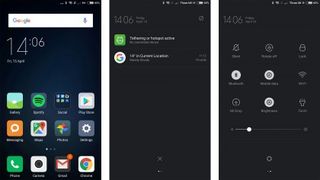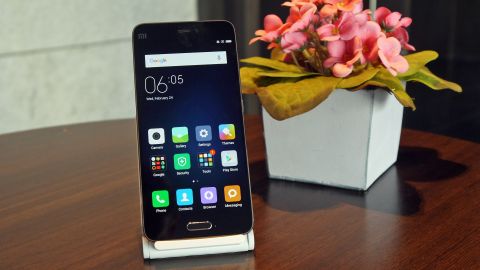Why you can trust TechRadar
The Xiaomi Mi5 runs a Qualcomm Snapdragon 820 processor, and as mentioned the model I'm testing is equipped with 3GB of RAM. It's fast – really fast; in some benchmarks it shows up as being the fastest phone on the market, although my tests didn't return quite that result, so I suspect that's the Pro model with 4GB of RAM.
It's also worth noting that this is a dual-SIM phone, a feature that's popular in Asian markets. That's probably one of the reasons why it won't show up on any UK networks – who wants to give someone a handset they can use on another network? – but it's a nifty feature, and will be worth its weight in gold when you travel and want to avoid your mobile network's roaming charges.
Right now the Mi5 is running Android Marshmallow software, but in some markets you can also have access to MIUI 8 from Xiaomi that offers Android 7 features.
We haven't been able to download the latest version of the software yet, but it's coming soon so we'll be sure to update this review when we see get it.
Xiaomi has so far been OK with updating its flagship phones to the latest software, there may just be a little wait for it to come to the Mi5.
One feature of the Mi5 is customisability. I'll give you an example: you can change the name of your SIM networks if you don't like the given names, and while that's a tiny point, most phones don't allow it.
You can also customise the look, you can install beta versions of MIUI (the UI Xiaomi uses), and even the ROM installation is made much easier than on other phones.

It's also possible to change the UI to match standard Android a little more closely. For example, by default, notifications aren't shown at the top of the screen as they are in Android, but changing this is only a menu-tap away, and you'll then see email, message and other notifications as you would on any other phone.
When trying out the various features on a new phone it's easy to forget that it is, actually, a phone. And so I departed from my normal habit of staring constantly at the screen, and made a telephone call. The call was clear, with ample volume; the speakerphone was also easily loud enough, and the quality here was good too.
There you go – I made a phone call so you don't have to.
Performance
- Features a powerful Qualcomm Snapdragon 820 processor
- Scored a great 3093 in benchmarking results
Here at techradar we like to use GeekBench 3 to compare phones fairly, and to give us a picture of what a handset is capable of achieving. The Xiaomi didn't romp to victory here, and again I think that's a RAM issue. It returned a single-core score of 1470 and a multi-core score of 3093.
For comparison I ran the same tests on a LG G5, which has the same processor but 4GB of RAM, and got a single-core result of 2296 and a multi-core score of 5277.
Now, I like to run benchmarks as much as the next person, but I also want to know how a phone performs in the real world – and the Xiaomi does brilliantly when it comes to all the usual things you're going to be doing with your handset.
Apps launch quickly enough – a short pause is inevitable when an app isn't already running in the background, but I certainly didn't feel like I was waiting for the phone.

Games are a pleasure to play. I tend to play Pocket Mortys a lot when I'm testing devices, and that's not a hugely demanding game – but games that use 3D graphics won't suffer on the Mi5, because it's powered by the Snapdragon 820 and has the Adreno 530 GPU pushing things along.
To truly test its graphical grunt I fired up Real Racing 3, not because it's the latest and greatest game, but because I've played it loads and know what to expect from it. Again, no complaints here – I didn't see any frame drops or general stuttering, and the graphics look, as they should, amazing on the HD screen.
Now seems like a good time to talk about audio quality too. In general I worry about the more left-field Android phones. Apple used to have trouble as well, but these days it's very solid, phones from LG and Samsung always perform well too, and the Xiaomi Mi5 was a pleasant surprise.
It has some utterly dubious EQ profiles built in, but if you ignore those and go with the defaults it sounds ace with Spotify Premium.
I also have some lossless and high-resolution tracks from Qobuz. I tested Selena Gomez' Hands to Myself – don't judge me – and it sounded excellent. I also have tracks from The Who and Taylor Swift that I use for testing, and again, no complaints. The LG G5 or HTC 10 might beat the Mi5 for sound, but I doubt most people would be able to hear much difference.

